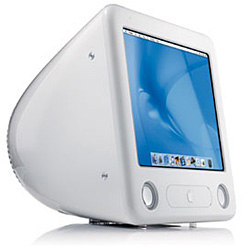Macs in the Enterprise
How to Upgrade Your eMac without Cracking the Case
- 2008.07.14 - Tip Jar
In a recent article, Carl Nygren talked about upgrading his eMac for better performance, including gaming and watching HD (high-definition) movies.
First, let me say I agree with his assessment of the eMac as an excellent and still-viable platform for, well, almost everything a person would want to use a computer for - word processing, web surfing, email, instant messaging, listening to music and watching movies, and running the iLife suite of applications. Given that the later models can run Leopard - and very well - says a lot about their staying power - and their viability even in the office. I say this as a man who once used an eMac much like Carl's as his only Mac, even going so far as to put Garage Band and iMovie through their paces.

However, there's something that Carl doesn't talk about in his article that I think needs some consideration - one should not open an eMac lightly. This isn't some generic, built-to-be-opened beige box PC we're talking about, but a finely tuned and tightly engineered all-in-one system, and there are some rules that must be followed. It's not the walk in the park that Carl makes it sound like when he refers to replacing the hard drive or installing that SuperDrive that he scored in his Dumpster Dell. He denigrates his own abilities as a technician when he glosses over the steps he took to ensure a successful upgrade.
That being as it may, there's no reason to run in terror from an eMac, even one as in need of an upgrade as the one that Carl started with.
The memory is the easiest upgrade. A single Phillips head screw is all that separates you from the memory compartment on the underside of the eMac. It's about as easy an upgrade as you get on an all-in-one computer system, and I highly advise it. Earlier eMacs used PC100 and PC133 RAM, which you can get for a song nowadays, and even these higher end units are thrilled with fairly common and similarly cheap PC2700 DIMMs. An upgrade from 256 MB of RAM to 1024 MB or more is cheap, easy, and will make you think you somehow managed to upgrade the processor along with the memory, because your system will react so quickly.
Where we go our separate ways is in upgrading the hard drive and optical drive. Again, when I began to use my eMac, it was my only Mac, and as such, I was loath to take the shroud off and tinker, lest I break something irrevocably.
But you have to consider: the eMac is nothing more than an iMac G4 made cheaper for the education market by the use of a CRT instead of an LCD. Like every iMac ever made, it is designed to be upgraded from the outside by judicious use of FireWire and USB.
My eMac has a 40 GB internal drive, just like Carl's. It's not fast (5400 rpm, if I recall correctly) and tends to fill up quickly if you start adding digital media. Because of that, I pulled a 300 GB drive from an old PC server I was no longer using, stuffed it into a powered USB hard drive case, and plugged it in. With a little Disk Utility tinkering, I had increased my storage space by 750% and never once had to crack the case.
On a similar bent, when I decided that I needed the ability to do more than just read DVDs with the built-in Combo drive, I hooked up a Sony FireWire DVD±RW drive. Again, the system recognized it immediately, and I had the ability to burn DVDs at need. The nicest part about this arrangement is that I can unplug and put the drive away when it isn't needed, which is, honestly, most of the time.
Hmm - I think I begin to understand the allure of the MacBook Air and it's external optical drive now.
We have similarly upgraded systems, Carl and I - his with a bit more memory, mine with a bit more hard drive space. Our eMacs are running the same OS and enjoying the same performance increases and increased lifespan because of it. And while replacing the internal components does leave additional ports available for future growth, and a faster internal drive does allow for better response from the operating system, adding capacity with external devices gives me similar results without the technical headaches.
And they say that Apples are hard to upgrade. Here are two different
ways, both of which worked fantastically and made a five-year-old
computer run a nine-month-old operating system and still support
software that was released yesterday.
![]()
Editor's note: I have the same eMac as Carl and Jason. After replacing the internal hard drive once, I swore it off. My preference is for an external 7200 rpm FireWire drive, which isn't only fast, but also easy to move from one Mac to another. Also note that only the last two generations of eMacs support USB 2.0, making FireWire a far better choice on the first and second generation models. dk
Join us on Facebook, follow us on Twitter or Google+, or subscribe to our RSS news feed
Today's Links
- Mac of the Day: PowerBook 190cs, introduced 1995.08.28. The last 680x0-based PowerBook could take a PowerPC upgrade.
- Support Low End Mac
Recent Content
About LEM Support Usage Privacy Contact
Follow Low End Mac on Twitter
Join Low End Mac on Facebook
Favorite Sites
MacSurfer
Cult of Mac
Shrine of Apple
MacInTouch
MyAppleMenu
InfoMac
The Mac Observer
Accelerate Your Mac
RetroMacCast
The Vintage Mac Museum
Deal Brothers
DealMac
Mac2Sell
Mac Driver Museum
JAG's House
System 6 Heaven
System 7 Today
the pickle's Low-End Mac FAQ
Affiliates
Amazon.com
The iTunes Store
PC Connection Express
Macgo Blu-ray Player
Parallels Desktop for Mac
eBay

